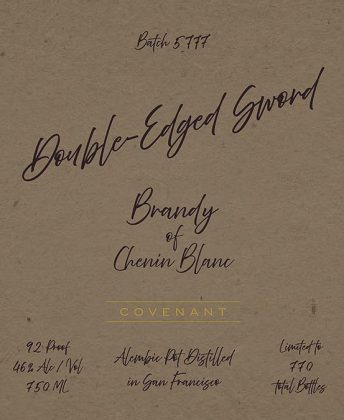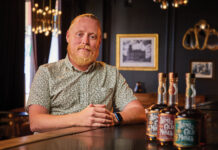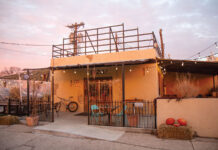According to the Alcohol and Tobacco Tax and Trade Bureau (TTB), vintage years are verboten on spirits labels. It was all Jeff Morgan — who makes wine, where it’s standard to put a year on the label — could do to refrain from putting the vintage on his Covenant kosher Double-Edged Sword brandy. He solved it by placing in a small font on top of the attractive caramel-custard brown label, the numerals “5777.” The number in the Hebrew calendar is “code” Morgan says, for the year 2017 — the vintage in which the Chenin Blanc grapes, the base for his brandy, were harvested.
Only 770 bottles of Double Edged (DE) were made. But sales, especially during last Passover, were brisk; quite a feat, since a 750 ml bottle sells for $175. Expect Covenant’s team — seasoned in making wine, but nascent to the business of spirits — to ramp up production by about 30 percent in the coming years.
The white Chenin grapes, from the Prince Vineyard in Clarksburg, CA — a delta wine region south of Sacramento — is well known for the varietal that is prominent in France’s Loire Valley appellation, as well as in South Africa. The Prince Vineyard is associated with Herzog Cellars, also a kosher California producer. The fruit for the first Double-Edged — low in sugar, high in acidity, and with a honey quality — was vinted at the urban Covenant Winery in Berkeley, and distilled at the late Leslie Rudd’s Distillery 209 on the San Francisco waterfront. (Rudd was a partner in the Covenant project.) However, 209 has been sold, which ended Covenant’s involvement there. Subsequent Double-Edged Swords have been and will be distilled at the Griffo Distillery in Petaluma, CA.
The wine for the project is unfiltered, uncolored and unsulfured. Morgan thinks his product is the only single-vineyard brandy on the US. market. Further, Morgan claims, a lot of brandy base wine is made with what he characterizes as “reject” grapes. Parenthetically and as a frame of reference, much of Cognac and Armagnac’s brandies use the grape variety Ugni Blanc and Colombard for their base. The Double-Edged, Morgan says is “essentially, an eau de vie or clear grappa” because it spent 24 months in barrel. The Chenin Blanc wine for the brandy was made by longtime Covenant winemaker Jonathan Hajdu and was aged in the winery’s used red wine oakwood.
The 41-year-old Hajdu has been making wine for Covenant since 2003. The ’17, or 5777, Double-Edged was the first time he worked with brandy. “That’s been a learning experience for us,” Hajdu concedes. “The first time, I made all the cuts myself. But I read up on where to make the cuts. The second vintage, we had some help from Mike Griffo [Griffo Distillery]. Both were distilled in [400-gallon] copper [alembic] pot stills. We wanted to make a brandy that had beautiful aromatics and make some like Bas Armagnac [whose Colombard base is grown in sandy soils, much as it is in Clarksburg]. Colombard is traditionally used, but we couldn’t find the right fruit; but Colombard is a descendant of Chenin.”
Hajdu makes it a point of emphasis that sulfur is not used in producing Double Edged. “We typically add sulfur at primary fermentation to protect the wine from oxidation; [but] sulfur would form on the copper. We ferment it as quickly as possible [10 days] and try to get it to the distillery as quickly as possible.” He further explains that the wine is tank-fermented in steel, as opposed to barrel fermentation.
The distillation process, he admits though, “is labor intensive and time consuming.”
To prove the point, Hajdu, along with Griffo’s distiller Mike Griffo, conducted three or four stripping runs. Each distillation took about six hours, and there were typically two a day. Hajdu explains, “You have to monitor the distillation throughout the day, and it’s at least a three-day project. For your final run, you’ve got to make your cuts — the heads, tails — and you’re constantly there, making sure your quality is good.
“Wine is also fairly time consuming,” he adds, but “not only do we have to go through the winemaking process, then we go through the distillation, and it’s all done by hand. It definitely adds a whole other level to our production.”
The effort, apparently, has paid off. “Before we set our process, we did some tasting with some brandies and Cognacs. We did really well. Because we spent so much time working on it and it’s such a small production, that’s where we need to be,” he concludes.
Apparently too, the experience working with the Covenant crew, for Mike Griffo, is very satisfying.
“We make a lot of brandy for different wineries and I find the quality of the brandy entirely depends on the quality of the wine. We have the pleasure of working with some great wines, and this wine was exceptional,” the distiller says. “This brandy stood out straight from the still; it came through with beautiful fruit, nice fat on the palate and a juicy finish. Oftentimes the fresh distillate has a tightness that requires time to rest and open up but this was one of the few that came over from the start with a beautiful complexity that only enhanced over time. Resting the brandy in-barrel for years layered the oak on the distillate foundation which married in a really nice pour.”
Griffo obviously was struck by the immediate results Double Edged took on, standing up directly from his still.
“Spirits typically need two or three months of resting to open up to reveal the full depth of complexity, and in my experience when the spirit is only two minutes old, it can be very tight,” he observes. “When you set the proof to 40% ABV and let it sit, over the course of minutes the spirit will change a great deal. Give it 15 minutes in the glass and you will have a completely different spirit that you had from the start. And so, with this spirit, it started off at birth (technically one minute from the still and 15 minutes in glass at 40%) with nice complexity and a great mouthfeel; which is unusually great. That’s why I think this spirit stood out straight from the still.”
And here’s the thing: Jeff Morgan and Hajdu brought the Double Edged in at 46% ABV.
When proofing the alcohol level from cask strength to bottle strength, Morgan explains, “We did trials, with water [to lower the alcohol]. I was thinking 42 to 43%. I didn’t want it too strong. We want to be able to drink this stuff. [And] the difference between 45 to 46 is astounding. It’s good at 45, but great at 46…. In the hands of an experienced distiller [Griffo], we harvest the best cuts and smoothest brandy possible.”
As to why a winery has gotten into the brandy-making business, Morgan admits, “This project started as a bit of a lark because we really love drinking Cognac and other distilled spirits, and I would like to build this brand into a much larger business once we have the means to do so. I really didn’t know that American grape brandy could be quite this good.”
Concludes Covenant winemaker Jonathan Hajdu: “At some point I’d like to experiment with grappa and other eaux de vie. I’m looking into making a pear eau de vie; and potentially getting our own still.”











